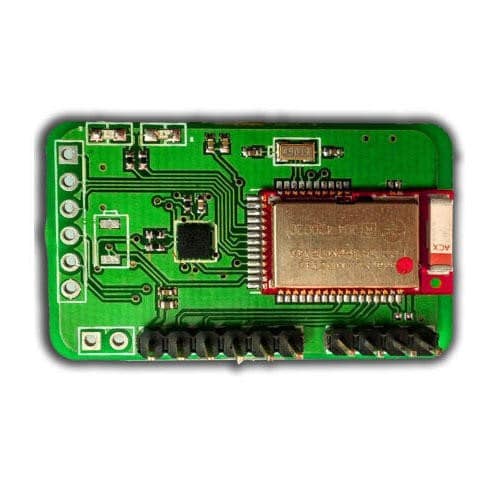Building your own IoT device is not as simple as it looks. The first hurdle is in putting the hardware together. Then comes the process of faithfully transmitting messages over the distance you need the signal to travel. Let us not forget the time it takes to develop your solution and the cost for it.
This innovation story introduces an evaluation board that helps you get your idea into a finished product quicker, and also lets you create an open access mesh network to send your data reliably up to 2km. The board in question is a Bluetooth Low Energy (BLE) and ANT based board by Atoll Solutions Pvt Ltd.
BLE-ANT, a useful combination
What makes this board special is the way it is put together, enabling faster time-to-market and low-power solutions. The board contains Raytac module with Nordic Semiconductor nRF51 chip, which offers support to BLE and ANT protocols.
Enabling mesh creation. Generally, when you communicate via Bluetooth, you can transfer data up to a maximum of 80m in open air, and about 18m in normal scenarios. With BLE-ANT combination, you can create a mesh network and connect up to 2km radius, with all devices connected to this mesh network.
When a device sends out a signal, it is communicated via the mesh, from one node to the other, until it reaches the end device. Thus, information is secure and a strong signal is received by the end user.
Low power consumption. A device designed using this board is mostly in sleep mode, awoken by signals only when it has work to do. The claim is that a coin-cell battery combined with this board’s power management scheme will let you use this board for about six months on a single charge.
Easily connected to existing setup. As soon as a module like ANT comes into the picture, the notion is that connecting to this might need a lot of effort from the user. This is where BLE module steps in, letting you connect to even your smartphone easily. Of course, there is some configuration you would need to do from your end, according to the application you choose, but the back-end is taken care of by the board.
Deep inside the board…
The board is built around Nordic Semiconductor nRF chip that comes in the form of MDBT40 board, with support for Bluetooth 4.0 and BT4.1 stack for BLE and ANT modules. It is designed based on Nordic nRF51422 solution. A 2.4GHz transceiver and an ARM Cortex 32-bit processor in the Nordic chip take care of the functioning.
Along with this, the board contains an accelero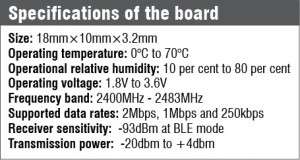 meter, ten configurable general-purpose inputs/outputs, three configurable analogue-to-digital converter channels, one 32-bit and two 16-bit timers with counter mode, and support for interfaces like universal serial bus, serial peripheral interface, inter-integrated circuit, universal asynchronous receiver/transmitter and central processing unit-independent programmable peripheral interconnect. It also includes advanced encryption to secure data you work with.
meter, ten configurable general-purpose inputs/outputs, three configurable analogue-to-digital converter channels, one 32-bit and two 16-bit timers with counter mode, and support for interfaces like universal serial bus, serial peripheral interface, inter-integrated circuit, universal asynchronous receiver/transmitter and central processing unit-independent programmable peripheral interconnect. It also includes advanced encryption to secure data you work with.
Low cost, low maintenance
Using this evaluation board will result in reduced cost as the module can directly be connected to sensors. To transfer data over longer ranges, you need not have multiple repeaters to strengthen the signal, thanks to the mesh network.
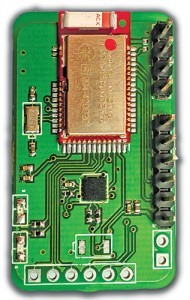
The only catch is the need to ensure that no node in the mesh fails. For this, automatic diagnosis can be scheduled once a week, which will alert you in case of any problem. As most of the configuration happens via software, it is also easy to regularly update the entire setup to make up for any glitches in the code.
Why the board
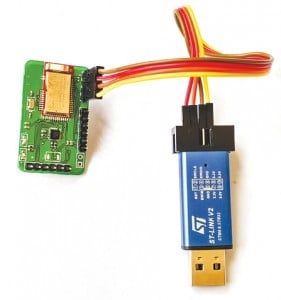
On the face of it, one might wonder why you should buy a board when you can put a system together yourself. Have a go at it and then the difficulties show up. If you purchase a Nordic chipset, you will need to design everything from the radio frequency module to every component on the board from scratch, putting in your time and effort for research and development. It would easily put you back by a month or two.
While going in for manufacturing, there might be damages due to welding of buses onto the board. If you still manage to get it right, the size might be an issue, not to mention power consumption of the complete design.The challenge is in getting the components together within the required dimensions, without affecting the range of the individual wireless module, managing power efficiency and providing battery backup.
Enabling faster time-to-market. With an inbuilt Cortex-M0 microcontroller, the board lets you create your design easily, and provides 32kb of memory to store your data, which is perfect for small applications. With the help of ST-Link/V2, an in-circuit debugger and programmer for the STM8 and STM32 microcontroller families, you can easily debug your program. The package is like a mini system on a chip, letting you connect via BLE port and code according to the chosen application. You can simply load the firmware into the board and begin your task right away.
What you can do with the board
The board is a solution to any application that requires a hardware circuit, software and a message to be transmitted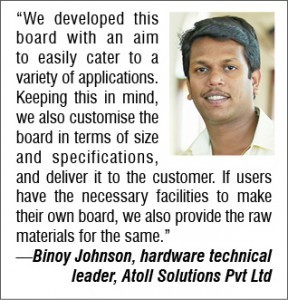 over a long area. It has already found its way to a few projects. Vehicle-tracking systems in cars have been implemented by integrating global positioning system with this solution. This proves to be very useful for safety purposes, tracking the exact location of the vehicle. With the protocols followed, the transmitted signal is found to be reliable and faithful.
over a long area. It has already found its way to a few projects. Vehicle-tracking systems in cars have been implemented by integrating global positioning system with this solution. This proves to be very useful for safety purposes, tracking the exact location of the vehicle. With the protocols followed, the transmitted signal is found to be reliable and faithful.
Another hot area of work is home automation. Especially as BLE module enables connecting to your smartphone easily, it is most comfortable for the user to stand in the hall and turn off the lights in a room on the first floor.
This setup also comes in very handy while designing wearables due to its compact size and low power consumption.
Meter monitoring is also a worthy mention.The developers took about two months to get this board working. Each board is priced at Rs 1400. More details about the product can be found on the website www.atollsolutions.com


